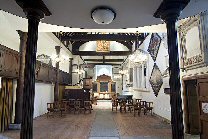|
|
|
|
History of St George's Church, Esher
|
|
|

|
St Georgeís Church was rebuilt in the 1540s and is one of the earliest churches built after the Reformation. It replaced an earlier -
possibly 13th century - building on this site. The
chancel and nave, the oak tie and collar beams of the open roof are all of the
period of Henry VIII. The south-west window embrasure, two small windows in the west gable, a bricked-up priestís door and the doorway to the
19th century vestry are also from that period. The
wooden clock-turret houses the
original clock mechanism from the early 17th Century,
the face and hour hand being added in 1783.
|
|
|
|
Few other changes were made to the structure for two centuries except for a series of alterations to accommodate changing liturgical fashions.
The installation of the pine altar rails, on orders from Archbishop Laud in 1640, provoked controversy and the 18th century saw an increased
emphasis on the sermon. To accommodate Thomas Pelham-Holles, Duke of Newcastle, from Claremont and his brother Henry Pelham of Esher Place, the
chamber pew, with its classical front of Corinthian columns surmounted by a pediment, was erected in 1725 by Sir John Vanbrugh and the
three-decker pulpit was installed directly opposite, the preacher being slightly higher than the occupants of
the pew. The
carved reredos over the altar dates from this period.
Vanbrugh also replaced the Tudor windows with those of Georgian style - the only remaining stained glass window being removed to the Great Hall of
Wadham College, Oxford. George IIís royal coat of arms hangs from the chancel beam.
|
|
|
|
St George's was the parish church of Esher until 1854, when Christ Church on Esher Green was built. It is therefore a rare example of
a village church of the Tudor, Stuart and Hanoverian days.
|
|
|
|
There are historical connections between the church and other residents of Claremont. Princess Charlotte, daughter of George IV and heir to the throne,
her husband Leopold, first King of the Belgians, his niece the young Princess - later Queen - Victoria with Prince Albert and their family all worshipped at
St Georgeís during the 19th century. In this period the growing population of Esher necessitated the building of the North aisle
(1812), two more galleries and a vestry.
|
|
|
|
St George's was neglected by the parish after 1854 and major repairs were required by 1911, when the floor had to be replaced and the box pews, installed in 1828, were removed.
A beautiful
memorial to the Princess Charlotte, carved by local sculptor F J Williamson, was given to the church by the Duchess of Albany in 1910.
The clock was restored in 1966 and later an electric winding mechanism replaced the old ropes and cannonball weights.
|
|
|
|
The church building is now in the care of the Churches Conservation Trust
visitchurches.org.uk. The Friends of St Georgeís Church,
a registered Charity, was established in 1986 to assist in the maintenance of the church and to use it for suitable purposes with the approval of the Trust.
The Churches Conservation Trust continues to carry out many expensive repairs to the church, carefully conserving the historic fabric.
|
|
|
|
The building is now the venue for St Georgeís Arts, supported by the
Friends of St Georgeís Church in partnership with The Churches Conservation Trust and the
RC Sherriff Trust. It is also still used for occasional services throughout the year.
|
|
|
|
For information about some of the Rectors of Esher who served at St George's, click here.
|
|
|
You can see a video about St George's here, and more photos of St George's here and
here.
|
|
|
|